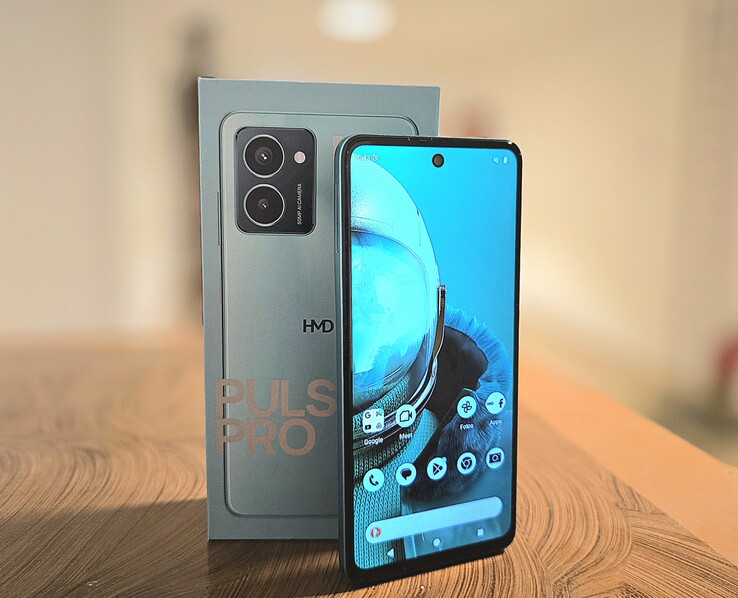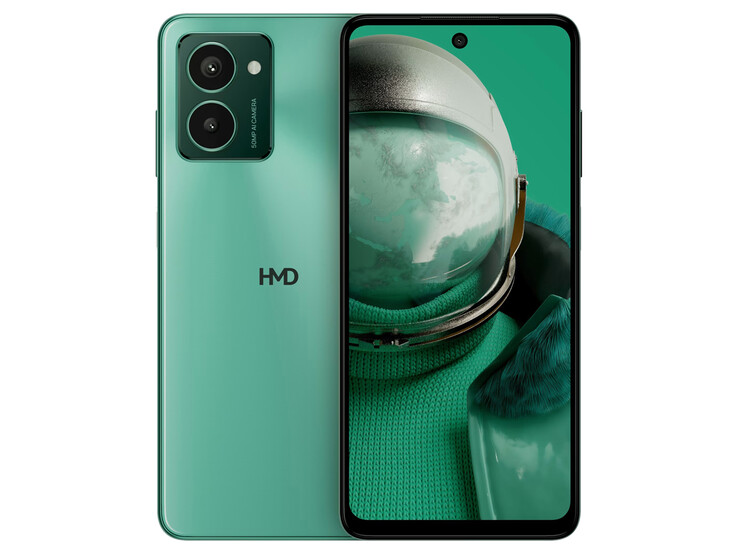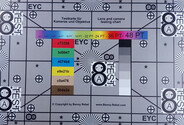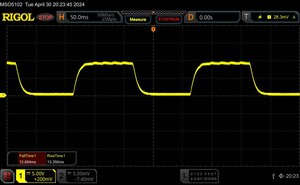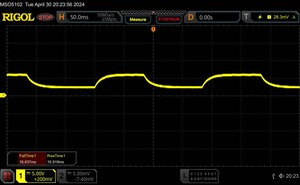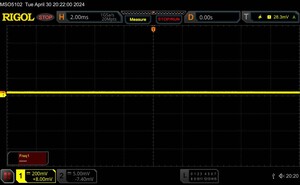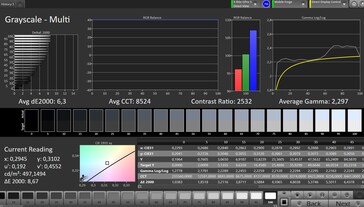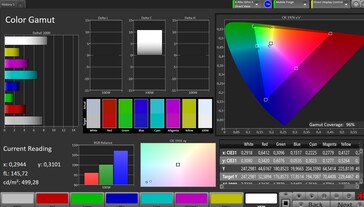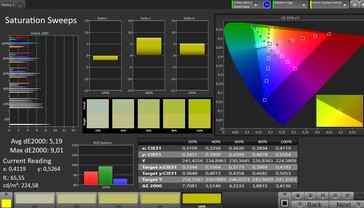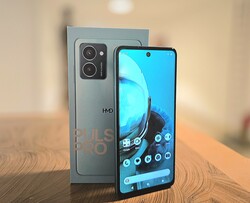HMD Pulse Pro smartphone review – Affordable, reparable and highly unique?
Comparison with possible competitors
Bewertung | Datum | Modell | Gewicht | Laufwerk | Groesse | Aufloesung | Preis ab |
|---|---|---|---|---|---|---|---|
| 77 % v7 (old) | 05 / 2024 | HMD Pulse Pro T7200 (T606), Mali-G57 MP1 | 196 g | 128 GB UFS 2.2 Flash | 6.65" | 1612x720 | |
| 79 % v7 (old) | 04 / 2024 | Motorola Moto G24 Power Helio G85, Mali-G52 MP2 | 197 g | 256 GB eMMC 5.1 Flash | 6.56" | 1612x720 | |
| 80 % v7 (old) | 04 / 2024 | Samsung Galaxy A15 Helio G99, Mali-G57 MP2 | 200 g | 128 GB UFS 2.2 Flash | 6.50" | 2340x1080 | |
| 80.2 % v7 (old) | 02 / 2024 | Xiaomi Redmi Note 13 4G SD 685, Adreno 610 | 188.5 g | 128 GB UFS 2.2 Flash | 6.67" | 2400x1080 |
Case and specifications – Beautifully designed plastic chassis
A new player on the smartphone market is always somewhat special, but the manufacturer in question here is actually a well-known figure: HMD has been producing Nokia phones since 2016, aiming to bring reparability and sustainability to the budget segment.
The HMD Pulse Pro is one of the first devices launched under the company's actual name – there won’t be any more new Nokia phones in future. As a start, the manufacturer has released a smartphone costing around €180 (US$190) that features a plastic body in three colourways: Black Ocean, Twilight Purple and Glacier Green. We are looking at a green model for this review.
All three colour variants have a glossy back that reflects light in several layers, creating a very stylish effect. But fingerprints may be visible after several hours of use.
The camera module is located at the top left corner of the rear and protrudes slightly from the body. It fits very cleanly in the chassis and looks sleek with its chamfered edges and dark material. The chassis has acceptable sturdiness: the device can flex with some force but doesn’t creak. Even a slight pressure can affect the liquid crystal in the display.
The front has a relatively large punch hole for the selfie camera and a somewhat prominent chin. That said, the phone’s design is fairly modern for the price bracket.
HMD has placed significant focus on the phone’s reparability. In collaboration with iFixit, the company is offering spare parts at fair prices (a replacement screen with a fix kit currently costs €45, or US$45). The corresponding guides can also be found on the website. HMD calls this “Gen 1 reparability” in a press release, suggesting future devices could offer even better reparability.
The Pulse Pro has 128 GB of speedy UFS storage and 6 GB of RAM at its disposal. It likewise supports NFC, which can be used for mobile payment services and scanning tags. You can connect a pair of headphones via the 3.5 mm audio jack, and the USB-C port supports both charging and data transfer.
The HMD Pulse Pro offers two SIM slots, but using a microSD card to expand the storage will require forgoing one of them. The card reader performed pretty well in our tests with our Angelbird V60 reference microSD card, delivering typical transfer rates for this class of phone and maintaining fairly stable performance.
| SD Card Reader - average JPG Copy Test (av. of 3 runs) | |
| Samsung Galaxy A15 (Angelbird V60) | |
| HMD Pulse Pro (Angelbird V60) | |
| Motorola Moto G24 Power (Angelbird V60) | |
| Average of class Smartphone (5.72 - 58.9, n=69, last 2 years) | |
| Xiaomi Redmi Note 13 4G (Angelbird V60) | |
Cross Platform Disk Test (CPDT)
Connectivity, software and operation – Complete with update promises
The HMD Pulse Pro supports up to Wi-Fi 5, meaning it’s capable of data rates between 300 and 350 Mbit/s. Though we saw minor fluctuations in our testing, transfer speeds remained quite stable overall.
Unfortunately, the new HMD phone doesn't support 5G. The device is also compatible with a limited number of 4G frequencies. As a result, whilst the Pulse Pro is usable across central Europe, you’ll need to check in advance whether it is able to access the 4G networks in your destination countries if you plan to travel further. In our tests at random locations in an urban environment, we found that the reception quality was solid but not as good as on high-end phones.
The phone ships with a fairly stock version of Android 14, but HMD has made a few changes that focus on digital detox. For example, the icons of preinstalled apps are in black and white, and the included ringtones are designed to be as calming as possible. Experts continue to work in this area to provide users with a more relaxing experience and help them put down their phones once in a while.
The manufacturer promises two OS updates (i.e. up to Android 16), which is by no means a given in this price range. Security updates will also be provided every quarter until at least May 2027. At the time of this review, the security patches were dated February 2024, meaning the next update should be round the corner.
The display is capable of running at 90Hz and thus responds swiftly and reliably to our inputs. The touchscreen works without any issues, even at its edges and corners. A fast and accurate fingerprint sensor is built into the right side of the device. The Pulse Pro also offers face unlock, but the light emitted by the display sometimes isn’t enough to make this feature work.
| Networking | |
| HMD Pulse Pro | |
| iperf3 transmit AXE11000 | |
| iperf3 receive AXE11000 | |
| Motorola Moto G24 Power | |
| iperf3 transmit AXE11000 | |
| iperf3 receive AXE11000 | |
| Samsung Galaxy A15 | |
| iperf3 transmit AXE11000 | |
| iperf3 receive AXE11000 | |
| Xiaomi Redmi Note 13 4G | |
| iperf3 transmit AXE11000 | |
| iperf3 receive AXE11000 | |
Cameras – More for snapshots
The megapixel counts of the cameras on the HMD Pulse Pro are easy to remember: both the main shooter and selfie camera have a resolution of 50MP. The rear camera is flanked by a second lens for creating a depth-of-field effect. However, this camera can't capture images on its own.
Photos taken with the main camera are quite sharp but exhibit mediocre contrast: some details are lost in situations with a bright foreground and dark background. In the photo of our surroundings, some areas are slightly overexposed, and objects in the foreground as well as details on large surfaces appear blurry. Some areas in the photo likewise look washed out and lack contrast. The main camera can effectively brighten dark images with a light source, but this also results in the loss of detail in brighter areas. The image appears blurry and quite grainy overall.
In our lab, under full lighting, the camera produced images with cool colour temperature. Occasionally, pixelated edges were observed around letters and numbers on a red background. But image quality is otherwise satisfactory. You can’t make out anything at all in photos taken at 1 lux of light.
The HMD Pulse Pro can record videos at up to 1080p and 30 fps. Auto exposure is quite snappy, but autofocus is visibly laggy and not always very accurate.
HMD has placed great emphasis on the 50MP selfie camera, which can be triggered using gestures such as a heart or peace sign. Our review team had a lot of fun with this very convenient feature. Sadly, the selfies themselves didn’t put us in such a good mood. Even at first glance, they look somewhat washed out and have hardly any detail in dark areas. Details appear fuzzy when the photos are enlarged.
Image comparison
Choose a scene and navigate within the first image. One click changes the position on touchscreens. One click on the zoomed-in image opens the original in a new window. The first image shows the scaled photograph of the test device.
Main camera: plantMain camera: surroundingsMain camera: low light

Display – No PWM on the Pulse Pro's screen
The HMD Pulse Pro’s IPS display, with a resolution of 1,612 x 720, is slightly behind what you might find on competing devices from Samsung and Xiaomi, which come with Full HD AMOLED screens. That said, the display technology and pixel count aren’t unusual in this price bracket.
With a peak brightness of 501 cd/m², the display is bright enough for outdoor use on cloudy days. In direct sunlight, it becomes difficult to see anything on the screen due to reflections. Thankfully, the black level is low, allowing the panel to achieve an excellent contrast ratio in our measurement. The resulting high colour intensity is somewhat marred by a blue tint on the panel, which has moderate colour accuracy.
We didn’t detect any PWM flicker, even at very low brightness.
| |||||||||||||||||||||||||
Brightness Distribution: 89 %
Center on Battery: 501 cd/m²
Contrast: 2947:1 (Black: 0.17 cd/m²)
ΔE ColorChecker Calman: 5.21 | ∀{0.5-29.43 Ø4.78}
ΔE Greyscale Calman: 6.3 | ∀{0.09-98 Ø5}
96% sRGB (Calman 2D)
Gamma: 2.297
CCT: 8524 K
| HMD Pulse Pro IPS, 1612x720, 6.7" | Motorola Moto G24 Power IPS, 1612x720, 6.6" | Samsung Galaxy A15 Super AMOLED, 2340x1080, 6.5" | Xiaomi Redmi Note 13 4G AMOLED, 2400x1080, 6.7" | |
|---|---|---|---|---|
| Response Times | -10% | 94% | 94% | |
| Response Time Grey 50% / Grey 80% * (ms) | 35.7 ? | 39 ? -9% | 2 ? 94% | 2.2 ? 94% |
| Response Time Black / White * (ms) | 26.1 ? | 28.6 ? -10% | 1.7 ? 93% | 1.6 ? 94% |
| PWM Frequency (Hz) | 187 | 389.2 | ||
| Screen | -25% | 48% | 70% | |
| Brightness middle (cd/m²) | 501 | 499 0% | 731 46% | 940 88% |
| Brightness (cd/m²) | 470 | 497 6% | 711 51% | 922 96% |
| Brightness Distribution (%) | 89 | 93 4% | 93 4% | 96 8% |
| Black Level * (cd/m²) | 0.17 | 0.49 -188% | ||
| Contrast (:1) | 2947 | 1018 -65% | ||
| Colorchecker dE 2000 * | 5.21 | 4.82 7% | 2.31 56% | 1.2 77% |
| Colorchecker dE 2000 max. * | 8.79 | 7.76 12% | 3.51 60% | 2.28 74% |
| Greyscale dE 2000 * | 6.3 | 4.7 25% | 1.7 73% | 1.4 78% |
| Gamma | 2.297 96% | 2.073 106% | 2.091 105% | 2.27 97% |
| CCT | 8524 76% | 7445 87% | 6424 101% | 6503 100% |
| Total Average (Program / Settings) | -18% /
-22% | 71% /
60% | 82% /
76% |
* ... smaller is better
Display Response Times
| ↔ Response Time Black to White | ||
|---|---|---|
| 26.1 ms ... rise ↗ and fall ↘ combined | ↗ 12.7 ms rise | |
| ↘ 13.4 ms fall | ||
| The screen shows relatively slow response rates in our tests and may be too slow for gamers. In comparison, all tested devices range from 0.1 (minimum) to 240 (maximum) ms. » 64 % of all devices are better. This means that the measured response time is worse than the average of all tested devices (20.2 ms). | ||
| ↔ Response Time 50% Grey to 80% Grey | ||
| 35.7 ms ... rise ↗ and fall ↘ combined | ↗ 18.8 ms rise | |
| ↘ 16.9 ms fall | ||
| The screen shows slow response rates in our tests and will be unsatisfactory for gamers. In comparison, all tested devices range from 0.165 (minimum) to 636 (maximum) ms. » 49 % of all devices are better. This means that the measured response time is worse than the average of all tested devices (31.6 ms). | ||
Screen Flickering / PWM (Pulse-Width Modulation)
| Screen flickering / PWM not detected | |||
In comparison: 53 % of all tested devices do not use PWM to dim the display. If PWM was detected, an average of 8111 (minimum: 5 - maximum: 343500) Hz was measured. | |||
Performance, emissions and battery life – Faster SoC needed
HMD has opted for a rather weak Unisoc T606 SoC for Pulse Pro. Even within this price range, there are now much more powerful phones available. In everyday use, you’ll have to contend with long waiting times and stuttering even when running basic apps or navigating through the menus.
However, HMD hasn’t cut corners when it comes to storage. The Pulse Pro uses UFS 2.2, which is fairly fast and reduces the time required to transfer and load data. This also helps the system to run quite smoothly despite having a relatively slow SoC.
We measured a peak temperature of 43.9°C (111.0°F) on the front of the phone. This is really noticeable and may even increase on warm days. The 3DMark stress test revealed that the SoC’s performance wasn’t affected by the heat.
On the bottom edge of the HMD Pulse Pro is a mono speaker that delivers decent sound. Its volume can be increased further with Audio Boost, but this will make it sound treble-heavy. The speaker sounds fuller with this feature disabled and delivers clear speech and vocals.
You can also connect external audio devices to the phone via the 3.5 mm audio jack or Bluetooth. In our testing, audio sounded clear with both methods. The Pulse Pro offers a good selection of wireless audio codecs: besides standard ones like SBC, AAC, aptX, aptX HD and LDAC, the slightly fancier Opus and LC3 are available as well.
The battery in the Pulse Pro has a capacity of 5,000 mAh, which is quite usual for most devices in this price bracket. The phone performed pretty well in our battery life comparison, lasting almost exactly 15 hours in our Wi-Fi test. It should have enough stamina to last a full day of frequent use. The phone can charge at up to 20 watts, but HMD didn’t include a charger.
| HMD Pulse Pro | Motorola Moto G24 Power | Samsung Galaxy A15 | Xiaomi Redmi Note 13 4G | Average 128 GB UFS 2.2 Flash | Average of class Smartphone | |
|---|---|---|---|---|---|---|
| AndroBench 3-5 | -63% | -8% | -13% | -22% | 84% | |
| Sequential Read 256KB (MB/s) | 966 | 297 -69% | 967.8 0% | 909.8 -6% | 736 ? -24% | 2216 ? 129% |
| Sequential Write 256KB (MB/s) | 824 | 253.2 -69% | 488.5 -41% | 606.3 -26% | 532 ? -35% | 1837 ? 123% |
| Random Read 4KB (MB/s) | 205 | 100 -51% | 233.2 14% | 177.1 -14% | 193 ? -6% | 294 ? 43% |
| Random Write 4KB (MB/s) | 239 | 92.2 -61% | 229.6 -4% | 228 -5% | 186.3 ? -22% | 334 ? 40% |
Temperature
(±) The maximum temperature on the upper side is 43.9 °C / 111 F, compared to the average of 35.2 °C / 95 F, ranging from 21.9 to 247 °C for the class Smartphone.
(±) The bottom heats up to a maximum of 40.6 °C / 105 F, compared to the average of 34 °C / 93 F
(+) In idle usage, the average temperature for the upper side is 23 °C / 73 F, compared to the device average of 32.9 °C / 91 F.
3DMark Wild Life Stress Test
HMD Pulse Pro audio analysis
(±) | speaker loudness is average but good (79.9 dB)
Bass 100 - 315 Hz
(-) | nearly no bass - on average 30.2% lower than median
(±) | linearity of bass is average (7.7% delta to prev. frequency)
Mids 400 - 2000 Hz
(±) | higher mids - on average 8.7% higher than median
(±) | linearity of mids is average (9.8% delta to prev. frequency)
Highs 2 - 16 kHz
(±) | higher highs - on average 5.6% higher than median
(+) | highs are linear (6.9% delta to prev. frequency)
Overall 100 - 16.000 Hz
(-) | overall sound is not linear (30.5% difference to median)
Compared to same class
» 79% of all tested devices in this class were better, 4% similar, 17% worse
» The best had a delta of 11%, average was 35%, worst was 134%
Compared to all devices tested
» 88% of all tested devices were better, 3% similar, 9% worse
» The best had a delta of 4%, average was 24%, worst was 134%
Xiaomi Redmi Note 13 4G audio analysis
(±) | speaker loudness is average but good (76.2 dB)
Bass 100 - 315 Hz
(-) | nearly no bass - on average 23.1% lower than median
(±) | linearity of bass is average (8% delta to prev. frequency)
Mids 400 - 2000 Hz
(±) | higher mids - on average 6.2% higher than median
(±) | linearity of mids is average (7.3% delta to prev. frequency)
Highs 2 - 16 kHz
(±) | higher highs - on average 5.2% higher than median
(±) | linearity of highs is average (10.9% delta to prev. frequency)
Overall 100 - 16.000 Hz
(±) | linearity of overall sound is average (22.5% difference to median)
Compared to same class
» 48% of all tested devices in this class were better, 6% similar, 46% worse
» The best had a delta of 11%, average was 35%, worst was 134%
Compared to all devices tested
» 65% of all tested devices were better, 6% similar, 29% worse
» The best had a delta of 4%, average was 24%, worst was 134%
| Battery Runtime - WiFi Websurfing | |
| Average of class Smartphone (12.1 - 54.1, n=212, last 2 years) | |
| Motorola Moto G24 Power | |
| HMD Pulse Pro | |
| Samsung Galaxy A15 | |
| Xiaomi Redmi Note 13 4G | |
Pros
Cons
Verdict – A decent start
With the Pulse Pro, HMD has created a commendable smartphone for their debut under their own brand. The phone offers a few features that are unique in the sub-€200 range, such as relatively high reparability with affordable spare parts, over three years of updates, and fast storage.
The manufacturer has given the chassis a stylish design, but a little more sturdiness would’ve been nice. The speaker offers okay sound, the battery lasts pretty long, and the display is fairly bright and doesn’t make use of PWM. However, the phone’s performance, in particular, didn’t quite impress; there are much faster alternatives in this price category.
The main camera is a little disappointing, even for a budget phone. The touted 50MP front camera also only takes modestly attractive selfies.
HMD set out to do a lot and has the potential to become a compelling alternative in future. But the manufacturer is still playing it very safe with the HMD Pulse Pro, offering a solid smartphone with good reparability and long update support for a modest price.
The HMD Pulse Pro is a nice-looking budget phone that is relatively easy to repair.
For alternatives, you might want to consider the Samsung Galaxy A15 4G or the Xiaomi Redmi Note 13 4G. Both devices offer more performance and feature AMOLED screens, but are not easily user-reparable and only comes with a limited update promise.
Price and availability
The HMD Pulse Pro is available directly from the manufacturer or online retailers like Amazon for €179 (about US$190).
You can check the company's website for international availability.
HMD Pulse Pro
- 05/02/2024 v7 (old)
Florian Schmitt
Transparency
The selection of devices to be reviewed is made by our editorial team. The test sample was provided to the author as a loan by the manufacturer or retailer for the purpose of this review. The lender had no influence on this review, nor did the manufacturer receive a copy of this review before publication. There was no obligation to publish this review. As an independent media company, Notebookcheck is not subjected to the authority of manufacturers, retailers or publishers.
This is how Notebookcheck is testing
Every year, Notebookcheck independently reviews hundreds of laptops and smartphones using standardized procedures to ensure that all results are comparable. We have continuously developed our test methods for around 20 years and set industry standards in the process. In our test labs, high-quality measuring equipment is utilized by experienced technicians and editors. These tests involve a multi-stage validation process. Our complex rating system is based on hundreds of well-founded measurements and benchmarks, which maintains objectivity. Further information on our test methods can be found here.




